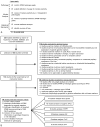Genetic markers of malignant transformation in intraductal papillary mucinous neoplasm of the pancreas: a meta-analysis
- PMID: 22750975
- PMCID: PMC4850028
- DOI: 10.1097/MPA.0b013e3182580fb4
Genetic markers of malignant transformation in intraductal papillary mucinous neoplasm of the pancreas: a meta-analysis
Abstract
Objectives: The objective of this study was to determine the relationship between specific genetic alterations and malignant transformation in intraductal papillary mucinous neoplasm (IPMN) of the pancreas.
Methods: Quantitative meta-analysis was conducted of studies through October 2010 that adhered to the 1996 World Health Organization guidelines for distinguishing adenoma and borderline IPMN versus carcinoma in surgically resected specimens using a random-effects model. We developed a 6-point scoring system to assess study quality.
Results: Thirty-nine studies (1235 IPMN samples) satisfied the inclusion criteria, and we conducted pooled analysis of 8 genetic markers: MUC1, MUC2, MUC5AC, kRas, p53, hTERT (human telomerase reverse transcriptase), cyclooxygenase 2, and Shh (Sonic hedgehog). Markers having the strongest association with malignant IPMN were hTERT (odds ratio [OR], 11.4; 95% confidence interval [CI], 3.5-36.7) and Shh (OR, 6.9; 95% CI, 2.4-20.2), whereas MUC5AC (OR, 1.0; 95% CI, 0.1-13.9) and kRas (OR, 2.0; 95% CI, 1.0-4.3) showed weak association with IPMN histologic progression.
Conclusions: Expression of hTERT is strongly associated with malignant transformation in IPMN, consistent with up-regulation of hTERT as a key step in progression of IPMN to cancer. Expression of kRas and MUC5AC is common but not strongly associated with IPMN histologic progression. The quality criteria used here may guide future reporting of genetic markers related to malignant transformation of IPMN.
Conflict of interest statement
The authors declare no conflict of interest.
Figures






Similar articles
-
The discrete nature and distinguishing molecular features of pancreatic intraductal tubulopapillary neoplasms and intraductal papillary mucinous neoplasms of the gastric type, pyloric gland variant.J Pathol. 2013 Nov;231(3):335-41. doi: 10.1002/path.4242. J Pathol. 2013. PMID: 23893889
-
Distinction of Invasive Carcinoma Derived From Intraductal Papillary Mucinous Neoplasms From Concomitant Ductal Adenocarcinoma of the Pancreas Using Molecular Biomarkers.Pancreas. 2016 Jul;45(6):826-35. doi: 10.1097/MPA.0000000000000563. Pancreas. 2016. PMID: 26646266
-
GNAS and KRAS Mutations Define Separate Progression Pathways in Intraductal Papillary Mucinous Neoplasm-Associated Carcinoma.J Am Coll Surg. 2015 May;220(5):845-854.e1. doi: 10.1016/j.jamcollsurg.2014.11.029. Epub 2015 Feb 11. J Am Coll Surg. 2015. PMID: 25840541 Free PMC article.
-
Thirty years of experience with intraductal papillary mucinous neoplasm of the pancreas: from discovery to international consensus.Digestion. 2014;90(4):265-72. doi: 10.1159/000370111. Epub 2015 Jan 10. Digestion. 2014. PMID: 25591885 Review.
-
[Will molecular diagnostics become established in pancreatic pathology?].Pathologe. 2013 Nov;34 Suppl 2:214-20. doi: 10.1007/s00292-013-1865-z. Pathologe. 2013. PMID: 24196616 Review. German.
Cited by
-
Clinical Perspectives on the Histomolecular Features of the Pancreatic Precursor Lesions: A Narrative Review.Middle East J Dig Dis. 2024 Jul;16(3):136-146. doi: 10.34172/mejdd.2024.387. Epub 2024 Jul 31. Middle East J Dig Dis. 2024. PMID: 39386334 Free PMC article. Review.
-
Preoperative risk prediction for intraductal papillary mucinous neoplasms by quantitative CT image analysis.HPB (Oxford). 2019 Feb;21(2):212-218. doi: 10.1016/j.hpb.2018.07.016. Epub 2018 Aug 7. HPB (Oxford). 2019. PMID: 30097414 Free PMC article.
-
Cyst Fluid Biosignature to Predict Intraductal Papillary Mucinous Neoplasms of the Pancreas with High Malignant Potential.J Am Coll Surg. 2019 May;228(5):721-729. doi: 10.1016/j.jamcollsurg.2019.02.040. Epub 2019 Feb 19. J Am Coll Surg. 2019. PMID: 30794864 Free PMC article.
-
Endoscopic ultrasound-guided fine-needle aspiration plus KRAS and GNAS mutation in malignant intraductal papillary mucinous neoplasm of the pancreas.Endosc Int Open. 2016 Dec;4(12):E1228-E1235. doi: 10.1055/s-0042-117216. Epub 2016 Nov 10. Endosc Int Open. 2016. PMID: 27995180 Free PMC article.
-
A retrospective study of histological outcome for IPMN after surgery in Lausanne, Switzerland: A case series.Ann Med Surg (Lond). 2020 Oct 20;60:110-114. doi: 10.1016/j.amsu.2020.10.028. eCollection 2020 Dec. Ann Med Surg (Lond). 2020. PMID: 33145018 Free PMC article.
References
-
- Hruban RH, Takaori K, Klimstra DS, et al. An illustrated consensus on the classification of pancreatic intraepithelial neoplasia and intraductal papillary mucinous neoplasms. Am J Surg Pathol. 2004;28(8):977–987. - PubMed
-
- Sessa F, Solcia E, Capella C, et al. Intraductal papillary-mucinous tumours represent a distinct group of pancreatic neoplasms: an investigation of tumour cell differentiation and K-ras, p53 and c-erbB-2 abnormalities in 26 patients. Virchows Arch. 1994;425(4):357–367. - PubMed
-
- Shimada K, Sakamoto Y, Sano T, et al. Invasive carcinoma originating in an intraductal papillary mucinous neoplasm of the pancreas: a clinicopathologic comparison with a common type of invasive ductal carcinoma. Pancreas. 2006;32:281–287. - PubMed
Publication types
MeSH terms
Substances
Grants and funding
LinkOut - more resources
Full Text Sources
Other Literature Sources
Medical
Research Materials
Miscellaneous

